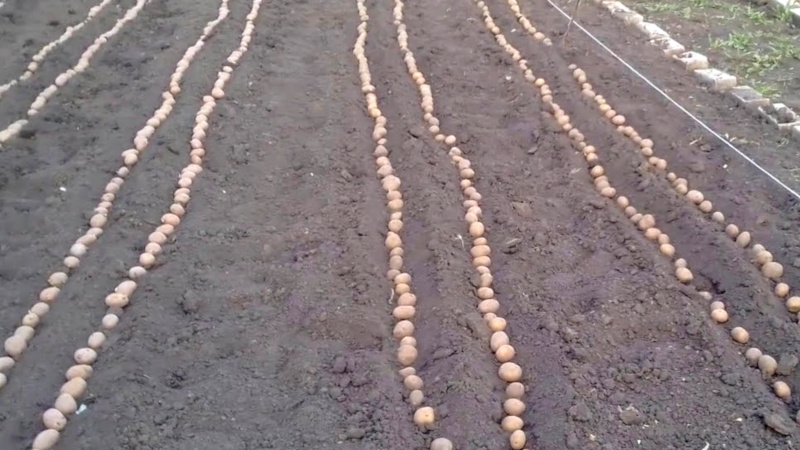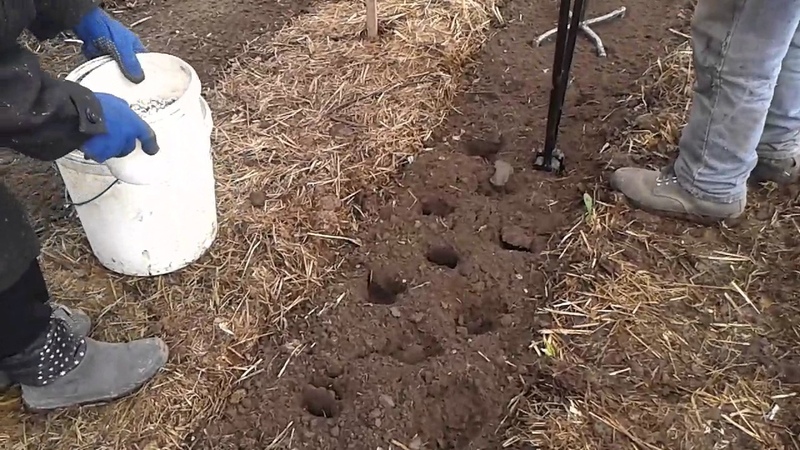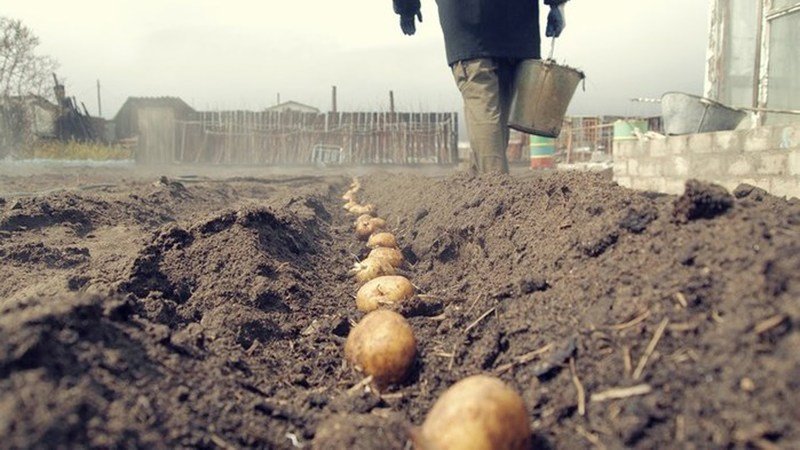What should be the planting depth of potatoes, what it depends on and what it affects
Many factors affect the yield of potatoes: the variety of the crop, the quality of the seed material, the fertility of the soil, and adherence to the care recommendations.
Another factor that not all novice gardeners know about is the depth of potato planting. Consider at what depth to plant the tubers and how this affects the growth and development of the bushes.
The content of the article
Planting depth of potatoes
Planting depth is the distance from the tuber to the soil surface. This factor determines whether young sprouts receive enough heat, oxygen and moisture.

Experienced gardeners deepen the planting potatoes by 5-15 cm. The exact distance from the tuber to the ground is determined based on the composition of the soil, the characteristics of the variety, the size of the seed, the method of sowing, and climatic features. Let's consider each of these conditions in more detail.
Soil composition
When cultivating on dense heavy soils (loam and clay soil), it is recommended to deepen the seed to a minimum distance (5-6 cm). On lighter sandy loam and peat soil, the distance increases to 8–10 cm. On light, loose fertile soils, potatoes are planted to a maximum depth of 10–12 cm.
Advice! When sowing, potatoes are buried equally over the entire area of the site. This will ensure uniform emergence and simplify further maintenance.
Features of the variety and size of tubers
Planting depth depends on the characteristics of the crop... When buying seed of a new variety, it is important to clarify how to plant it correctly.
The larger the tuber, the deeper it is buried, and vice versa. If small potatoes are planted too deep, there is a chance they will not sprout.
Sowing method and climate
There are some unusual sowing methods that require shallow or deep seeding. For example, for planting under straw lightly sprinkle potatoes with earth.
In a rainy, cold spring, vegetables are planted closer to the soil surface so that they do not rot and receive enough heat. If the weather is dry and warm, the plants are sown a couple of centimeters deeper so that the tubers get enough moisture to grow.
Landing in ridges and trenches
Sowing potatoes in ridges and trenches are essentially opposite sowing methods. Both of them allow you to successfully grow healthy tubers, even if the site is poorly located and in the wrong soil.

Into the ridges
This planting method is used with a high level of groundwater in the garden. It has proven itself well in heavy soils.
The earth is dug up, leveled and even furrows are marked on the surface. Hand tools (hoe, shovel, hoe) or mechanized assistants (walk-behind tractor, cultivator) shovel the earth along each furrow, forming a ridge.
Important! When the plot is located in a low swampy place, planting in the ridges avoids rotting and grows a healthy crop.
The height of each ridge is 15–20 cm. The distance between them is 50–70 cm. Sowing tubers are laid out on top of each elevation and sprinkled with earth 8–10 cm.
In the trenches
Planting potatoes in trenches is shown on light and loose soils. In this case, ridge sowing is ineffective, as the elevations will crumble and wash away with rains.
The trenching method is used in dry hot climates, on sandy or sandy loam soils.
Trenches about 15 cm deep are dug on the site, at a distance of 50–70 cm from each other. Put potatoes on the bottom and sprinkle with earth.
The planted tubers receive sufficient moisture and are protected from overheating.
Traditional smooth landing
Landing under a shovel is carried out both manually and using various devices.
Manual sowing
When sowing by hand, furrows are first marked in the prepared area. Then the rows will turn out to be even, which simplifies further maintenance. An interval of 50–70 cm is maintained between them.
In each row, dig holes 8-10 cm deep at a distance of 25-30 cm from each other. The plantings do not thicken, otherwise the risk of damage to the bushes during hilling and weeding will increase, which will contribute to the spread of diseases.
After the preparatory stage is completed, put a potato in each hole.
Helpful! To increase yields, compost, humus, fertilizers are poured into the pits.
Holes from the planted row are covered with earth from those in the next row. This is repeated until the end of the section.

Using a walk-behind tractor
Special devices facilitate the hard work of the summer resident. One of the most modern and multifunctional devices is a walk-behind tractor.
This sowing technology is similar to manual sowing. First, even grooves are cut on the surface of the earth, planting material is laid out in them and covered by hand with a rake or a motor-cultivator.
Planting depth is at least 10-15 cm, and the distance between tubers is 25-30 cm.
When the furrows are formed, a gap of at least 70 cm is left between them, so that during subsequent processing the wheels move freely between the rows without damaging the bushes.
Using a potato planter

The potato planter is a special device that is attached to the walk-behind tractor and allows you to plant potatoes in one go. The tool simultaneously makes furrows, spreads the tubers and sprinkles them with soil.
At the same time, it is easy to monitor how the planting depth of tubers is regulated and correct it if necessary.
Planting depth depending on the region

When determining the planting depth of seed potatoes, the region of cultivation is also taken into account.
In areas with hot and dry summers, vegetables are planted deeper to prevent overheating and to provide sufficient moisture.
When cultivated in Siberia and the Urals, where the summers are short and cool, the depth of planting is reduced. This will provide the tubers with enough heat and will not rot during the rainy season.
It is interesting:
Competent planting of potatoes before winter: step by step instructions.
How and from what to sprout potatoes before planting.
What types of dressings are best used when planting potatoes.
Conclusion
When determining the optimal planting depth, the characteristics of the soil, the region of cultivation, varietal characteristics, the size of the sown tubers and the method of planting are taken into account. Potatoes are sown both by hand and with the help of modern technology.
By correctly determining the planting depth, it will be possible to obtain uniform seedlings, simplifying the care of the crop.